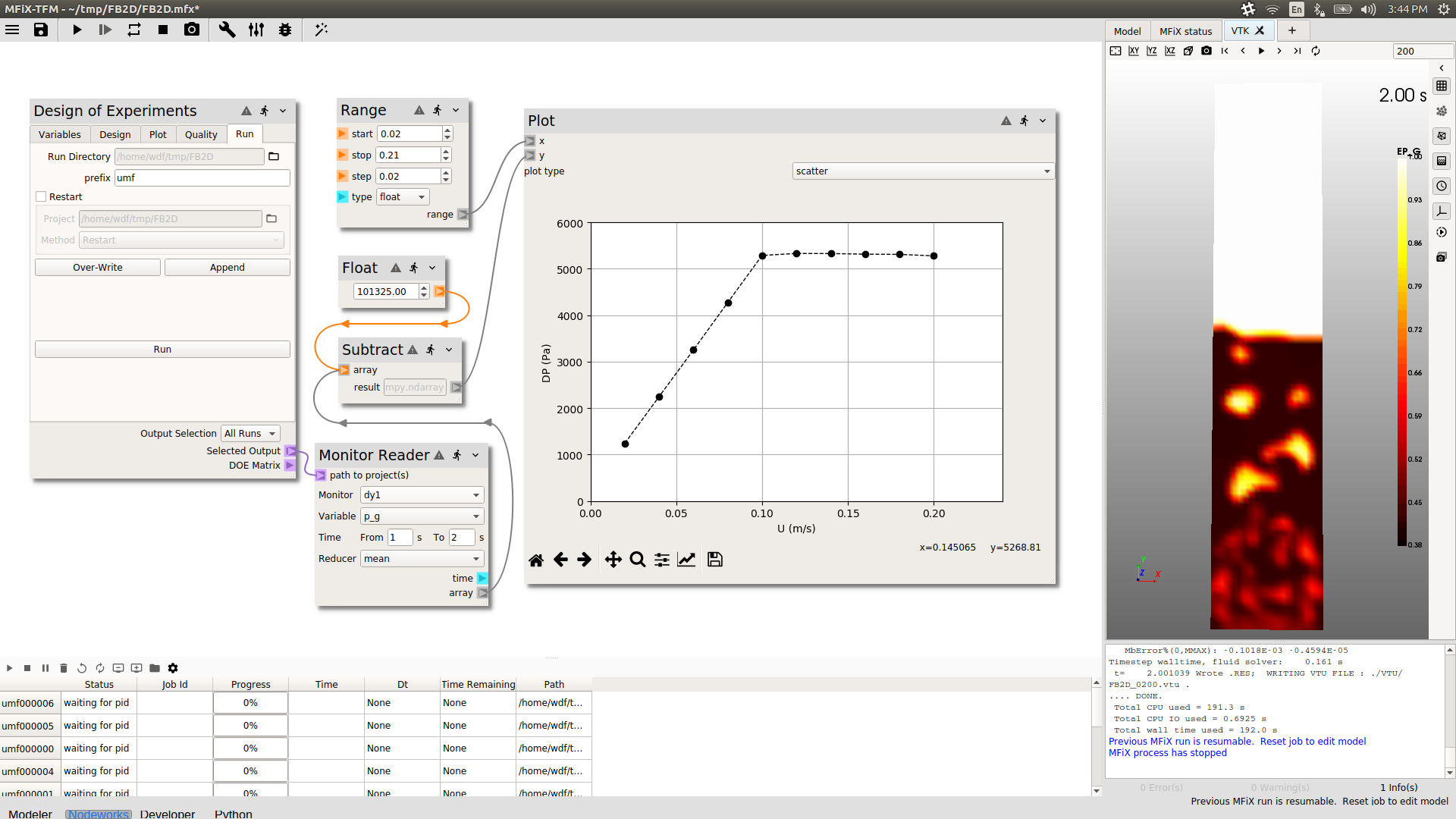Ex. 1: Minimum Fluidization¶
In this first simple example, we’ll use a pre-defined MFiX case contained in the GUI to examine some of the MFiX-Nodeworks interactive features by tracing out a \(U_{mf}\) curve.
Create MFiX case¶
First enter your local MFiX environment and launch a new instance
mfix -n.Navigate to the
Newpane in theFile Menuand select the caseFluidBed_2D, give the project name and location and hitOKto create the case.In order to trace out \(U_{mf}\), we’ll need to adjust the inlet velocity. Although we could just find the MFiX intrinsic variable name in the Nodeworks dictionary, let’s give it something more identifiable. Navigate to the
Boundary conditionspane, and select the region named Bottom Inlet. Right click on theY-axial velocityentry, selectCreate Parameterand give the inlet velocity a meaningful name. In the following, we’ll name it inflow.Now, we need to create a monitor to record the pressure drop in the bed. We want to compute the averaged the bed gas-phase pressure near, but not at, the inlet. First, in the
Regionspane, clickto add a new region. We’ll call this region dy1, which will range in
Xfromxmintoxmaxand inYfrom 0.01 to 0.01, i.e., uniform at one vertical grid spacing \(\Delta_y\). The case is 2-D so theZrange of the region can be left at zero.Now we can go to the
Monitorspane, click thebutton to create a monitor. We’ll set the monitor type to average then highlight the dy1 region we just created and hit
OK. Set theTypetoAverageand theFilename baseto DPbed. The defaultWrite intervalis likely sufficient, but we’ll reduce it to 0.01 (s) for slightly more temporal resolution. At a minimum, make sure to checkPressureas the monitor data to write.Before moving to nodeworks make sure to save the case. If running the GUI without a distributed default solver, we recommend also building a project solver at this time.
Sweep parameter space¶
Now that we have a base case, we can perform a parameter with the surrogate modeling and analysis tools available in Nodeworks. In this example, we just have a simple 1-D parameter space in the parameterized inflow variable. However, the general procedure can be followed for more complex sampling of higher-dimensional parameter spaces. To begin, navigate to the
Nodeworkstab in the bottom toolbar to open up a blank Nodeworks worksheet.Right click on the sheet and add a
Design of Experimentsnode from theSurrogate Modeling and Analysisnode collection in the node library.Click
in the
Variabletab to add a new variable.Now, we want to vary the gas inlet velocity which was parameterized as inflow or your user specific name. Click on the
variableentry and type the parameterized variable name. You should see the variable appear in the tab-completion drop down menu as you type.(Optional) Label the
unitsas (m/s).Now we need to determine how many points (or samples) to run and over what range. We’ll sweep from zero (exclusively) to 0.20 (m/s), by intervals of 0.01 m/s. Set
fromto 0.01,toto 0.12 andlevelsto 10.Now navigate to the
Designtab. Set theMethodto factorial and check theUse variable specific levelsoption. Alternatively, the global levels could be entered here on theDesigntab. Click theBuildbutton to generate the samples and verify by the table entries or in thePlottab that the desired points are set.Navigate to the
Runtab and set theprefixof the subdirectories to umf. ClickOver-Writeto create the subdirectories, each containing an individual .mfx file. You should notice messages in the console window indicating that the twelve .mfx files have been exported from the master file (base case).Now we are ready to run the jobs. Click on the
Runbutton and select either your distributed default mfixsolver or local project build and then clickRunin theRun solverpop-up window. You should notices additional messages in the console window announcing running jobs.
Warning
In some distributions, Nodeworks can not determine the job ID leaving the MFiX server
waiting for pid. If this occurs, please manually check if jobs are running and when
they have completed. Additionally in Step below use the Output Selection option
All Runs.
Determine \(U_{mf}\)¶
After the jobs have completed, right click on the Nodeworks worksheet and add a
Monitor Readernode from theMFIXcollection in the node library. Set theMonitorto the DPbed monitor we created previously and theVariableto p_g. We will neglect the first 1 (s) of simulation as transient data and average in timeFrom1To2 (s). Set the dataReducerto mean.Add a
Rangenode from the numpy collection in the node library. Set thestart,stopandstepto 0.02, 0.21 and 0.02, respectively.Add a
Plotnode from thematplotlibcollection in the node library.Connect the nodes. Set the
Output Selectionto completed or all runs and connect theSelected Outputterminal of the DOE node to thepath to project(s)terminal of theMonitor Readernode. Connect thearrayterminal of theMonitor Readerto theyand the range terminal to thexterminal of thePlotnode.Finally, press
to run the sheet and generate the \(U_{mf}\) curve as shown below, predicting a value of approximately 10 (cm/s).

Note
As is, the bed pressure is not a pressure drop as the outlet (atmospheric) pressure
is included. There are several ways to remove the outlet pressure, one of which would
be to create a second monitor near the outlet. However, since the outlet pressure is
a constant across all runs, this can be handled in Nodeworks by adding a Subtract
node–make sure to use the numpy version–and a Float node with a value of the outlet
boundary condition of 101325 Pa. Connect the monitor then the float to the subtract
node and then the subtract node to the plot node in order to arrive at the Umf plot
shown above.